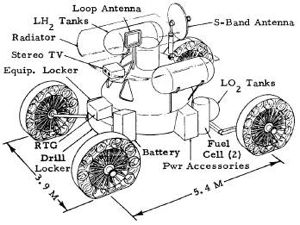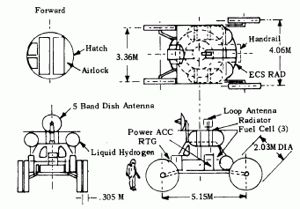
Home - Search - Browse - Alphabetic Index: 0- 1- 2- 3- 4- 5- 6- 7- 8- 9
A- B- C- D- E- F- G- H- I- J- K- L- M- N- O- P- Q- R- S- T- U- V- W- X- Y- Z
MOCOM
 MOCOM |
AKA: Mobile Command Module. Status: Study 1966.
For the same mobility mission as MOLEM, the MOCOM weighed about 4300 kg. Power was supplied primarily by fuel cells using cryogenically stored reactants. An RTG provided power needs for quiescent storage.
In 1966 the MOCOM was evaluated by Bendix against other concepts in the MOBEV study under contract NAS8-20334. Here the MOCOM configuration was modified to a common standard for comparative purposes. The MOCOM cabin was mounted on the chassis with the major axis of the Command Module cone in a vertical position. This was done to accommodate the design of the docking adaptor. The astronaut position in the cabin and internal furnishings and operational equipment were revised to compensate for the attitude change between the MOCOM and the Command Module from which it was derived. The MOCOM concept met the cabin free volume and delivered mass restraints; however, it did not provide any weight margin for possible growth. None of the three mobility derivative vehicles (MOLEM, MOCOM, and MOCAN) were retained as MOBEV Design Point Vehicles. They did not offer the planner any measurable advantages in terms of performance, mass, or cost over a system which was designed specifically for mobility use, such as MOLAB.
MOCOM Summary
- Delivered Mass (kg): 3535
- Cabin Free Volume (ft3): 219
- Total Mission Energy (kwh): 695
- Mobility Specific Energy (kwh/km): .49
- Maximum Average Speed-ELMS (km/hr): 10.
- Obstacle Negotiability: (cm) 70
- Crevice Negotiability: (cm} 157
- Development Cost: ($million) 282.3
- Development Time (years): 4.75
- Storage Envelope and Mass: LM Truck, 3860 kg
- Crew Size: Two, 95th Percentile
- Scientific Mission Duration: 14 Days (+7 Day Life Support Contingency)
- Lunar Standby Period: Six Months
- Operating Period: One lunar Day and/or Night
- Scientific Payload & Energy: 320 kg and 73 kWH
- Mobility Range & Radius: 400 km and 80 km
- Surface Model: ELMS: 50/50 Maria and Highland
- Ingress/Egress Cycles: 40
- Vehicle Operation: Manned and Remote Control
Comparison of significant characteristics for MOLEM, MOCOM, and MOCAN showed that each of the designs provided for a crew of two and a scientific payload of 320 kg for a 14-day mission with a 400-km range. The only vehicle exceeding the LM Truck payload capability of 3860 kg for a full-up mission was the MOCAN. Since the delivery mass constraint had been exceeded, MOCAN performance had to be degraded to a 200-km, 8-day mission in order to meet the assumed LM Truck payload. The cabin free volumes, with the exception of MOLEM, were within the NASA stipulated desired volume of 175 cu ft for a two-man, 14-day mission. Fuel cell systems were used for primary power and were sized to supply the total energy requirements of 693, 695, and 734 kwh, respectively, for the MOLEM, MOCOM, and MOCAN. Mobility specific energy for MOLEM, MOCOM, and MOCAN were, respectively, 0.44, 0.49, and 0.59 kwh/km. The maximum average speed was 10 km/hr, over a 50/50 ELMS and 16.7 km/hr on a hard surface for all three vehicles. Obstacle and crevice negotiability was based on vehicle geometry. For MOLEM, MOCOM, and MOCAN, respectively, the obstacle negotiability was 80, 70, and 60 cm; and the crevice negotiability was 173, 157, and 146 cm. Development costs of $273.3 million for MOLEM, $282.3 million for MOCOM, and $291.7 million for MOCAN do not include the cost of 13 basic development shells or the flight shell. Development time for all three mobility derivatives was 4.75 years.
Family: Lunar Rovers, Moon. Country: USA. Agency: NASA, North American. Bibliography: 1993.
 | MOCOM |
Back to top of page
Home - Search - Browse - Alphabetic Index: 0- 1- 2- 3- 4- 5- 6- 7- 8- 9
A- B- C- D- E- F- G- H- I- J- K- L- M- N- O- P- Q- R- S- T- U- V- W- X- Y- Z
© 1997-2019 Mark Wade - Contact
© / Conditions for Use